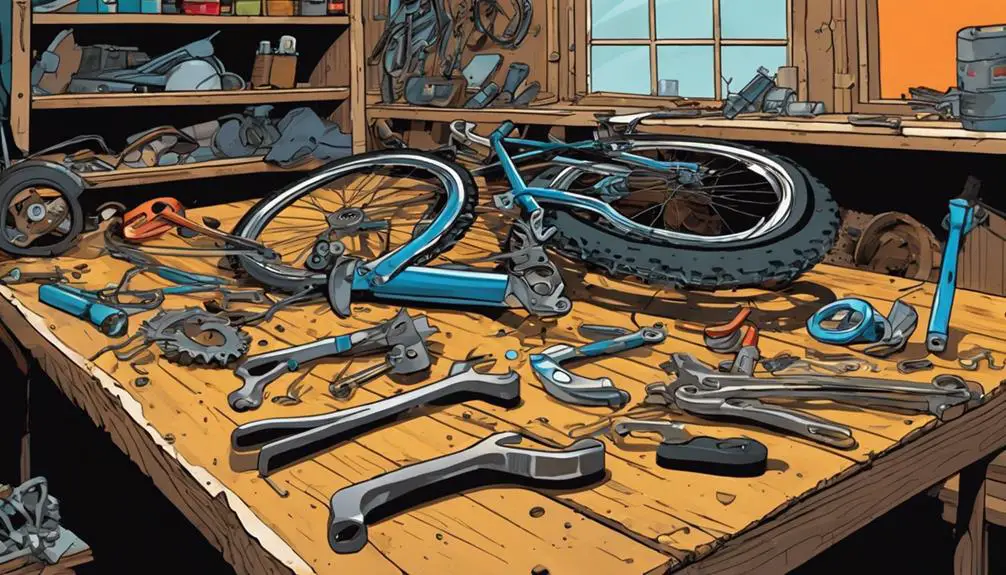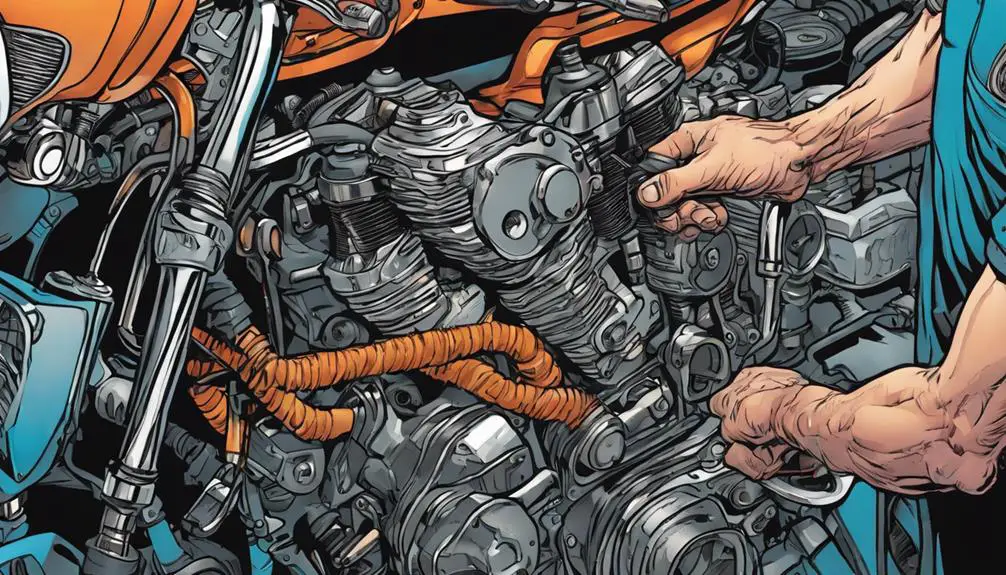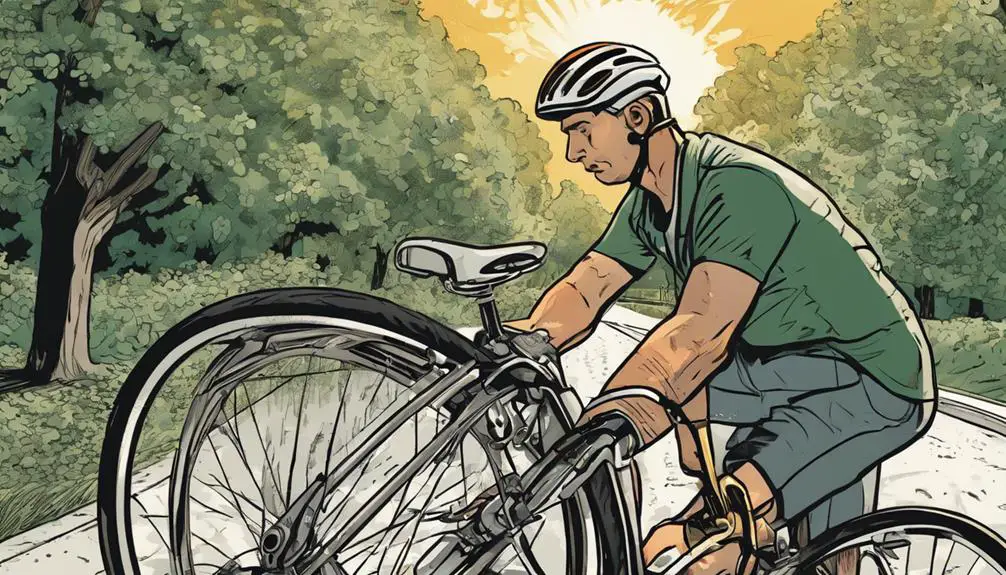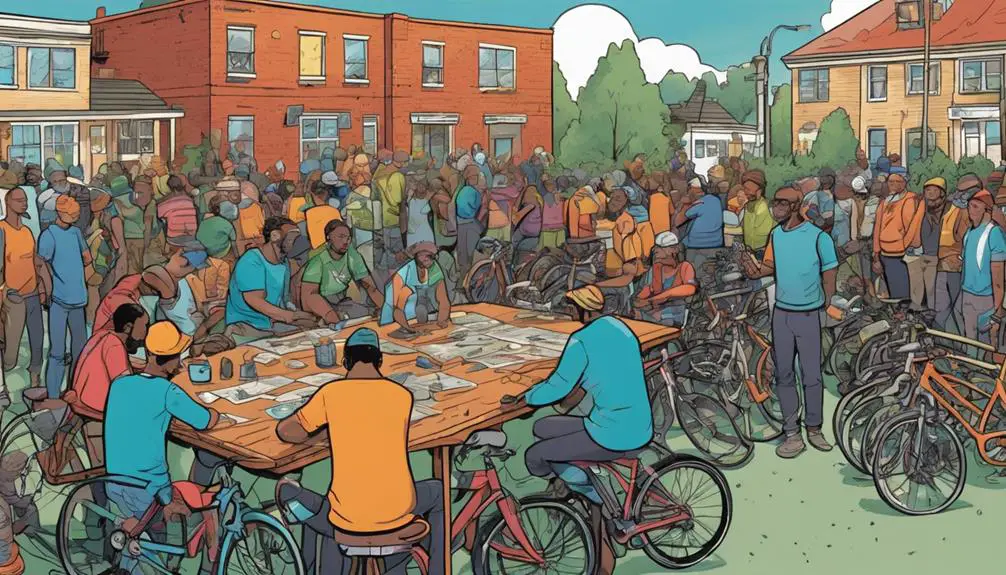Did you know that nearly 30% of cyclists experience mechanical issues each year? If you're one of them, you understand how frustrating these challenges can be. Fortunately, there are practical steps you can take to sidestep many common problems and keep your rides smooth. From tire maintenance to understanding your bike's electrical system, there are effective strategies worth exploring. So, what are the key tips that can transform your biking experience and help you ride with confidence?
Quick Takeaways
- Regularly check tire pressure and tread depth to prevent flat tires and ensure optimal performance.
- Clean and lubricate the chain frequently to avoid shifting issues and enhance drivetrain efficiency.
- Inspect brake components regularly for wear and adjust cables to maintain effective stopping power.
- Monitor battery and wiring conditions to prevent electrical failures and ensure all components function properly.
Understanding Common Bike Issues

When you ride your bike regularly, you'll likely encounter common issues that can affect your performance and safety. One of the most frequent problems is a flat tire. It can derail your ride, but you can easily empower yourself by learning how to fix it. Carry a patch kit and a pump, and practice changing a tire at home. You'll gain confidence and freedom on the road.
Another common issue is chain problems. A dirty or rusty chain can slow you down and cause shifting issues. Regularly clean and lubricate your chain to keep it running smoothly. This simple maintenance can enhance your ride and keep you feeling like the wind in your hair.
Don't forget about brake performance, either. Squeaky or unresponsive brakes can pose serious safety risks. Check your brake pads and cables regularly, adjusting or replacing as necessary.
Lastly, pay attention to your gears. If they're not shifting properly, it can limit your riding experience. Keep your bike tuned, and you'll find that these small issues won't hold you back. Embrace the freedom of riding by staying proactive with your bike's care!
Troubleshooting Electrical Problems
If your bike has electrical components, knowing how to troubleshoot common issues can save you time and frustration on your rides.
Start by checking the battery. Make sure it's charged and properly connected. Loose or corroded terminals can prevent your bike from firing up, so give those a quick clean and tighten.
Next, examine the fuses. If a specific component isn't working, a blown fuse might be the culprit. Replace it with one of the same amperage and see if that solves the problem.
Don't forget to inspect the wiring. Look for frayed or damaged wires that could disrupt the electrical flow. If you find any, you might need to replace or repair them to get back on the road.
Maintaining Your Motorcycle's Engine

Regularly checking and changing your motorcycle's oil is crucial for keeping the engine running smoothly. Neglecting this important task can lead to a host of problems that could leave you stranded on the open road. Embrace the freedom of riding by maintaining your engine with these straightforward tips:
- Check the oil level: Look at the dipstick regularly; low oil means trouble.
- Change the oil regularly: Follow the manufacturer's recommendations for intervals and always use high-quality oil.
- Inspect the oil filter: A clean filter guarantees better circulation; replace it when you change the oil.
- Monitor engine temperature: Overheating can damage your engine, so keep an eye on the temperature gauge.
Addressing Tire Wear and Tear
Tire wear and tear can considerably affect your motorcycle's performance and safety, so it's essential to keep a close eye on their condition. To maintain that sense of freedom on the open road, start by regularly checking your tire pressure. Under-inflated tires can decrease handling and fuel efficiency, while over-inflation can lead to blowouts.
Next, inspect the tread depth. You want enough tread to grip the road, especially in wet conditions. A simple way to check is using the penny test—insert a coin into the tread; if you can see Lincoln's head, it's time for new tires.
Don't forget to look for any cracks, cuts, or bulges on the tire surface. These issues can compromise your safety and should be addressed immediately. Additionally, consider rotating your tires regularly to guarantee even wear.
Lastly, remember that riding style affects tire longevity. Smooth acceleration and braking can help extend tire life. By paying attention to these details, you'll not only enhance your motorcycle's performance but also embrace the thrill of the ride with confidence.
Dealing With Brake System Concerns

When it comes to your bike's brake system, regular inspections are essential to guarantee safety and performance.
You'll want to adjust the brake cable tension and replace any worn brake pads to keep everything functioning smoothly.
Staying on top of these maintenance tasks can make a big difference in your riding experience.
Inspect Brake Components Regularly
Inspecting your brake components frequently can prevent serious safety issues and guarantee a smooth ride. When you're out there cruising, you want to feel secure knowing your brakes are in top shape.
Here are some key components to check regularly:
- Brake Pads: Look for wear and tear. If they're too thin, it's time to replace them.
- Brake Rotors: Verify they're straight and free of debris. Any warping can affect braking performance.
- Brake Levers: Test their responsiveness. They should return smoothly without sticking.
- Cables and Housings: Check for frays or cracks. Damaged cables can compromise your braking power.
Adjust Brake Cable Tension
Adjusting your brake cable tension is essential for ensuring your brakes respond quickly and effectively when you need them most. If your brakes feel sluggish or unresponsive, it's time to take charge and make the necessary adjustments. You don't have to be a bike mechanic to tackle this challenge!
Start by locating the barrel adjuster on your brake lever or caliper. Turning it clockwise tightens the cable, while counterclockwise loosens it. Pull the brakes and check their response; they should engage without too much pull. If the brakes feel too loose, tighten the cable until you achieve a firm grip.
Next, inspect both brake pads. They should make even contact with the rim when you pull the lever. Adjust the pads if necessary, then give everything another test. You're aiming for that satisfying, immediate stop when you squeeze the brake handle.
Don't forget to check the cable for fraying or wear. If it's worn out, it's time to replace it. Taking these steps not only enhances your bike's performance but also empowers you to ride with confidence.
Enjoy the freedom of the open road!
Replace Worn Brake Pads
After ensuring your brake cable tension is just right, it's time to focus on replacing worn brake pads to maintain ideal stopping power. Worn pads can lead to longer stopping distances and decreased control, so don't overlook them. Here's how to tackle this essential task:
- Check for wear: Look for grooves or uneven surfaces on your brake pads. If they're flat or have significant wear, it's time for a change.
- Gather your tools: You'll typically need an Allen wrench, new pads, and possibly a screwdriver. Keep it simple!
- Remove the old pads: Loosen the bolts holding the brake pads in place, then slide them out carefully.
- Insert new pads: Slide in the new pads, ensuring they fit snugly and align properly with your rim.
Replacing worn brake pads isn't just about safety; it's also about enjoying your ride, knowing you can stop on a dime.
Enhancing Fuel Efficiency
To boost your bike's fuel efficiency, focus on maintaining proper tire pressure and ensuring your engine is running smoothly. Under-inflated tires create more resistance, making your bike work harder and consume more fuel. Check your tire pressure regularly and inflate them to the manufacturer's recommended levels.
Next, keep your engine well-tuned. Regular oil changes and timely maintenance not only extend your bike's life but also enhance its performance. A well-oiled engine runs more efficiently, giving you the freedom to ride longer distances without excessive fuel consumption.
Consider adjusting your riding habits, too. Smooth acceleration and braking can notably reduce fuel use. Avoid hard starts and sudden stops; instead, anticipate the road ahead to maintain a steady pace.
Lastly, think about your bike's weight. Removing unnecessary items can lighten your load, allowing your bike to perform better and save on fuel.
Finding Support in Communities

Joining local biking communities can greatly enhance your riding experience, providing not just camaraderie but also valuable resources and support. When you connect with fellow cyclists, you tap into a wealth of knowledge and inspiration. It's a fantastic way to break free from isolation and feel empowered on your biking journey.
Here are some benefits you can expect from joining a local biking community:
- Shared Knowledge: Learn from experienced riders about maintenance, routes, and safety tips.
- Group Rides: Enjoy organized rides where you can push your limits and meet new friends.
- Events and Workshops: Participate in community events that promote biking and provide hands-on learning opportunities.
- Advocacy: Join forces with others to advocate for better biking infrastructure and safer roads.
Common Questions
How Often Should I Clean My Bike's Chain?
You should clean your bike's chain regularly to keep it running smoothly. Aim for every 100-150 miles or after riding in wet or muddy conditions.
If you notice the chain looking dirty or feeling rough, it's time to give it some attention. A clean chain not only enhances your ride but also extends the life of your bike.
What Tools Are Essential for Basic Bike Maintenance?
For your bike maintenance, you'll need a few essential tools to keep rolling smoothly.
Grab a multi-tool for quick adjustments, a tire lever for easy flat fixes, and a pump to keep your tires inflated.
Don't forget a chain cleaner and lubricant for a smooth ride.
With these tools, you're not just fixing; you're empowering your journey, liberating yourself from breakdowns, and embracing freedom on two wheels.
How Can I Improve My Bike's Visibility at Night?
To improve your bike's visibility at night, start by adding bright, reflective lights to both the front and rear.
Consider wearing reflective clothing and using stick-on LED lights on your helmet or bike frame.
You can also attach reflective tape to your bike for extra visibility.
Make sure your bike's reflectors are in good condition, too.
These simple upgrades will help you ride confidently, knowing you're seen by others on the road.
What Are Signs of a Worn-Out Bike Seat?
A worn-out bike seat can feel like a weight holding you back, while a fresh one liberates your ride.
You'll notice signs like visible cracks, sagging, or discomfort during your rides. If you're constantly shifting to find comfort or experiencing soreness, it's time for a change.
Don't let an uncomfortable seat limit your freedom—embrace the open road with a seat that supports your adventures and keeps you pedaling joyfully!
How Do I Choose the Right Helmet for Safety?
Choosing the right helmet for safety is essential.
Look for a helmet that fits snugly without pinching your head and meets safety standards like CPSC or ASTM.
Try on different styles—full-face or traditional—to see what feels best for you.
Adjust the straps so they sit just below your ears and buckle comfortably under your chin.
Wrapping Up
So, next time you find yourself stranded with a flat tire or struggling to shift gears, remember that the real challenge isn't the bike; it's your willingness to keep it in shape.
You could always opt for a stationary bike, right? But where's the fun in that?
By embracing these tips and engaging with your biking community, you'll not only tackle those pesky issues but also cultivate a newfound appreciation for the ride—irony has never felt so liberating.